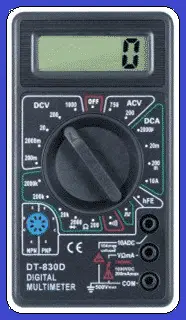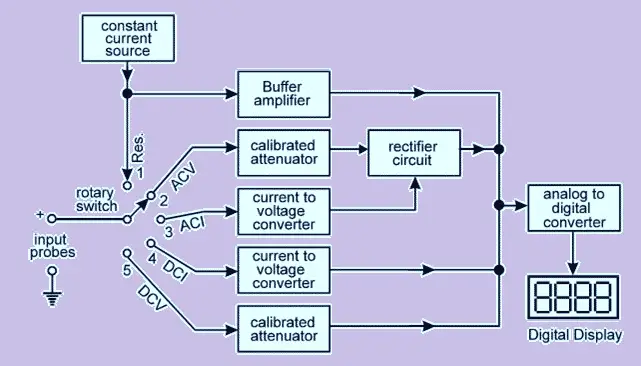Digital Multimeter is an electronic test equipment which measures the AC/DC voltage and provides the reading in digital numeric mode. It has successfully replaced its age old counterpart , Analog multi-meter, which provides the reading with a pointing needle on a fixed scale. This test equipment may be used to measure the continuity of wire/circuit too.
The biggest advantage of a Digital Multi-meter is its numeric reading as it decreases the chances of reading-errors on the scale (parallaxing) from a human-eye. In addition to that , it also boosts the reading-speed and its digital reading/value can be recorded as well as used as a feed for other devices.
The digital multimeter is commonly available in various voltage levels (AC & DC both), current levels and resistance levels depending on your requirement and costing from mere bucks to thousands of it.
How to use a Digital Multi-meter for:
-
Measuring Voltage.
- Choose the suitable task by the selector knob as AC/DC and voltage (V) Section.
- Then select the necessary range by the selector knob. Always select the range more than the voltage to be measured.
- Connect the probe with the multi-meter and place it to the i/p marked with polarity (i.e the plus and minus sign).
- Use High Voltage probe, if you have to measure voltage beyond 1KV.
-
Measuring Current.
- Choose the suitable task by the selector knob as AC/DC and current (A) Section.
- Then select the necessary range by the selector knob. Always select the range more than the current to be measured.
- If you are measuring a current below 02 Amps, Connect the probe with the multi-meter and place it to the i/p marked with polarity plus and minus sign. For measuring a current from 2-10 Amps, the probe’s high i/p is to be connected to the 10A probe point.
-
Resistance Measurement
- Choose the suitable task by the selector knob as “OHM” Section.
- Then select the necessary range by the selector knob. Always select the range near to the resistance value.
- Connect the probe with the multi-meter and place it to the i/p marked with polarity (i.e the plus and minus sign).



I got useful insights from your article about digital multimeter, their uses, graphical explanation in the image. it’s short, good and informative.
xtbje6
e192w5
f45foi
I like this web site very much, Its a real nice office to read and find info .
I have to show appreciation to you for rescuing me from such a crisis. Just after researching throughout the online world and seeing techniques which were not productive, I assumed my life was gone. Existing minus the answers to the difficulties you’ve resolved by way of your good short post is a critical case, as well as the kind which might have negatively affected my career if I hadn’t noticed your website. Your actual understanding and kindness in touching every aspect was priceless. I’m not sure what I would’ve done if I had not come upon such a stuff like this. I am able to at this time look forward to my future. Thanks for your time very much for this expert and sensible help. I won’t think twice to propose your blog post to any individual who desires support about this subject.
naturally like your website but you have to check the spelling on several of your posts. Several of them are rife with spelling problems and I find it very bothersome to tell the truth nevertheless I will certainly come back again.
I like this website very much, Its a really nice office to read and obtain information. “…when you have eliminated the impossible, whatever remains, however improbable, must be the truth.” by Conan Doyle.
Thank you for the sensible critique. Me and my neighbor were just preparing to do a little research about this. We got a grab a book from our local library but I think I learned more clear from this post. I am very glad to see such great information being shared freely out there.
Your point of view caught my eye and was very interesting. Thanks. I have a question for you.
Thanks for sharing. I read many of your blog posts, cool, your blog is very good.
I have not checked in here for a while because I thought it was getting boring, but the last few posts are good quality so I guess I will add you back to my everyday bloglist. You deserve it my friend 🙂
Thank you for every other informative site. The place else may just I get that type of info written in such a perfect way? I’ve a undertaking that I’m just now working on, and I have been on the look out for such information.
Very detailed
Well I truly liked studying it. This subject procured by you is very effective for accurate planning.
Loving the info on this web site, you have done great job on the blog posts.
I like this post, enjoyed this one thank you for posting. “He removes the greatest ornament of friendship, who takes away from it respect.” by Cicero.